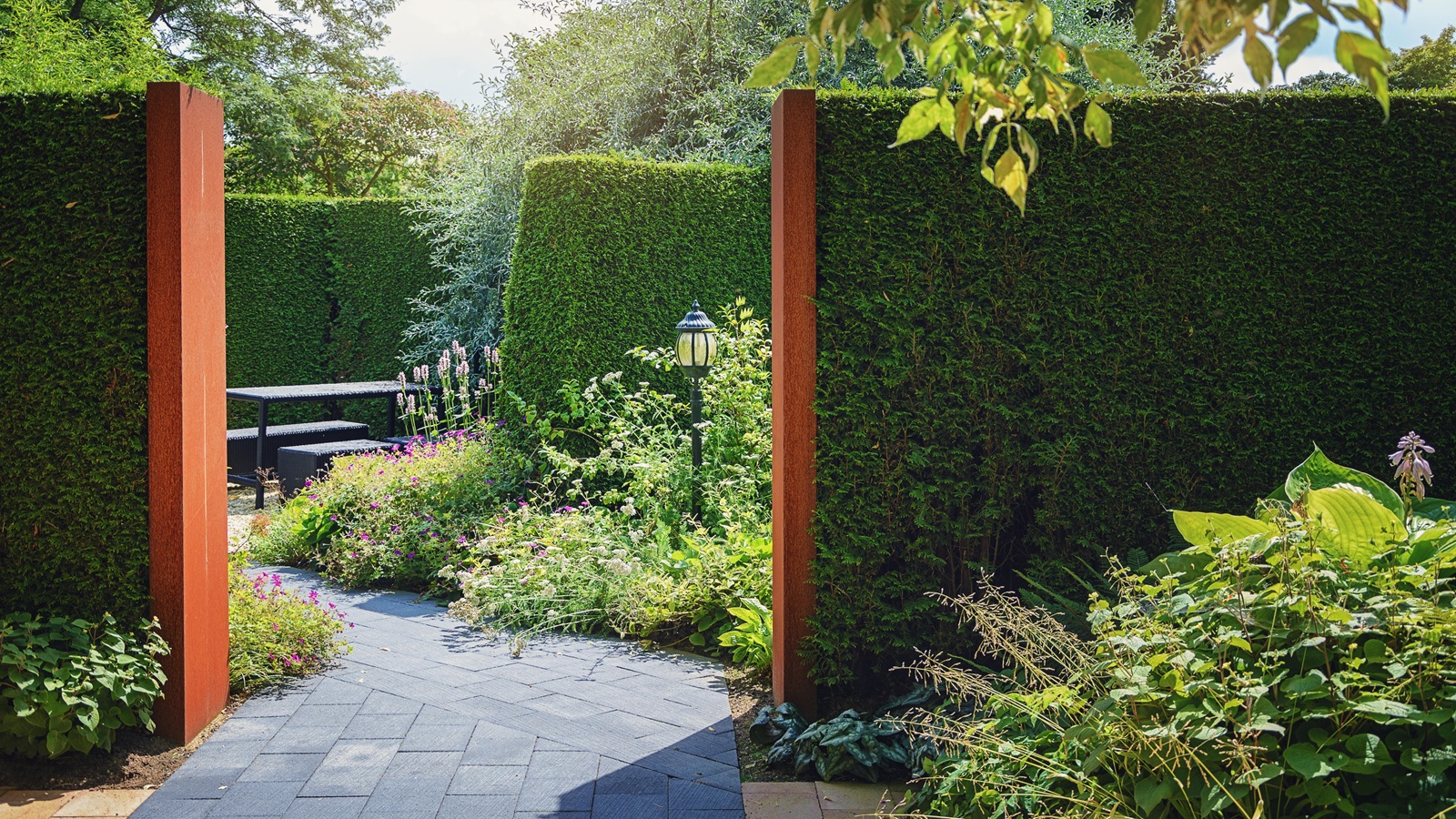If you have been struggling getting the most from a narrow yard, or simply don’t know where to start planning and planting, a good starting point is to understand the most common narrow garden mistakes. Often stretching like a corridor away from the house or hugging the property’s perimeter, long and lean gardens can be daunting to plan. With access through the plot a priority, these spaces, however beautifully designed can often appear dull, lacking in character and with nowhere to encourage you to stop and linger.
Although they are an easy footprint in which to make common landscaping mistakes , by following some simple design rules these awkward shaped yards can become dreamy and practical outdoor spaces. We asked landscape designers to highlight the most frequent narrow garden mistakes and give advice on how to avoid them. 1.

Don’t cut your views short Narrow yards can feel overwhelming, especially if they are flanked by high, straight boundaries along each side. One of the worst design decisions you can make is to surround the space with tall straight and solid fences, walls or hedges as not only will these cut out natural daylight but also exaggerate the plot’s extreme proportions. Thankfully by making just a few simple changes, such as introducing the occasional opening – or at least creating the illusion of one – can make a difference to how you perceive the limited space.
Nestling outdoor mirror ideas into hedges, fencing panels or decorative screens can be impressively deceiving. Reflecting nearby views and natural light, they can give the impression of a larger plot and break the monotony of an imposing boundary. Other landscaping options include replacing solid fence panels with sections of latticework, fretwork screens or even clipping portholes into mature hedges.
Adding some depth and form into a flat garden boundary can be enough to create the feeling of extra width and interest, even if it doesn’t offer the prospect of a distant view. 'When working in a narrow space, using borrowed views can help add visual depth. Try to avoid tall fences, hedges and screening,' says landscape designer Stacilyn Feldman .
'If you’re up against a large existing hedge that can’t be removed, use that to your advantage. Add a smaller hedge in front of it to bring the scale down and keep the planting bed narrow on your parcel. The new hedge should be less than 5’ tall and will help transition scales between spaces, while also maintaining your garden space.
' 2. Avoid a bowling alley, and link garden rooms instead Create garden rooms that visually link together It may sound counterintuitive but designing a long narrow plot so you can see the entire length uninterrupted will actually make the space feel more confined than if you divide it up. Due to the power of perspective and how we process and perceive the space around us, understanding this is key to making the most of a narrow plot.
'Unless you’re specifically planning for a bocce court or boules, consider breaking up a long narrow space into a series of garden rooms,' advises Stacilyn. 'For the best results each room should be visible from one to the next. Create a dining space, lounge space and maybe a growing garden to break up the length and separate each by a hedge, or a change in paving to maintain each zone’s individual identity.
' 3. Steer clear of mismatched paving Thanks to their limited width, narrow plots can easily appear fussy, dated and overcomplicated. Keep the impression spacious, soothing and harmonious with a limited palette of hard landscaping materials.
This is particularly important when it comes to choosing paving, as the eye is naturally drawn to the surface upon which we walk. With so many different materials and finishes to pick from, paving decisions can be tricky, but it is crucial to weigh up practicality and future maintenance along with aesthetics. 'There are two schools of thought on paving in narrow spaces: Detailed paving carpets will play well with dining and lounge spaces, but in a more garden-like setting, larger paving slabs will take the focus off the ground plane and onto the plants or the views,' says Stacilyn Feldman.
Stacilyn Feldman is a Principal at Oehme, van Sweden in Washington, DC. She has designed, managed, and shepherded over a decade’s worth of the firm’s landmark projects including green roofs, urban development, botanic gardens, and residential estates. Stacilyn holds a Bachelors of Landscape Architecture from The Pennsylvania State University.
4. Ditch airy, wild style planting for rhythm and structure Airy, meadow style planting can appear twee and fussy in narrow spaces 'For narrow spaces I often use more structured repetition of plantings as wild and varied plantings often feel overwhelming in a small area,' says landscape architect Elliot Rose. 'Using a rhythm of tall and narrow screening plants, such as podocarps, bamboo, or pittosporum, with smaller reliable plants between them, can create a sense of a natural corridor.
' Vary your planting choice depending on your chosen style of yard. For instance, clipped spheres and cones of yew, bay and box holly look stunning running through a English style border bursting with salvia, veronica, frothy euphorbia and coral bells. Looking for a more naturalistic look, then be sure to add in dramatic Red Switch grass available from Walmart or Calamagrotis 'Karl Foerster' available at Walmart at regular intervals and surround with sun loving blooms such as echinacea and sanguisorba.
Elliot also suggests to, 'try to minimize using too many different plant varieties as these spaces are often passageways or pathways to reach the larger more open parts of the garden where you can have more varied plantings, mixing up sizes, color and texture.' 5. Resist a kaleidoscope approach to color For many garden lovers, experimenting with new color combinations provides endless joy and satisfaction.
Whether it’s trying out a new bold foliage pairing, introducing a fresh floral accent shade or an area of contrasting paving, there’s fun in flexing those creative instincts. While this design approach works in a large open plot, for a narrow space, too many different colors can prove jarring. Making the area feel mismatched and chaotic, it can visually reduce the space.
Landscape designer Andrea Scharff recommends to, 'Keep color palettes and materials simple, use no more than five plant varieties and two hardscape materials to keep this space harmonious.' Growing up in Marin County, Elliot worked alongside his father who owned a construction business that operated throughout the Bay Area. Following his college studies in landscape design and horticulture, he went on to open a commercial aquaponics farm in Half Moon Bay, which eventually led to his career in landscaping.
At a local high-end design and build firm, Elliot served as a construction foreman and assistant designer until he opened Wildwood Landscapes. Elliot continues to bring his passion for design and strong technical construction background to every project, leading clients from the initial site-visits to the polished installation. A Virginia native, Andrea Scharff grew up surrounded by some of the nation's most beautiful and historic gardens.
After working in the tech industry for Fortune 500 companies she realized she preferred to be out in the garden. After studying Landscape Design at the New York Botanical Garden she started her landscape firm in LA 20 years ago. Andrea Scharff Landscape Design specializes in residential and commercial landscaping.
Her designs have recently been featured in Sunset Magazine, The Los Angeles Times Homes Styles Section, and Luxe Magazine. 6. Avoid harsh linear pathways Use sweeping paths to detract from a narrow plot There’s nothing inviting about a linear path that stretches from A to B in a narrow plot.
Devoid of interest, intrigue or places to sit and relax, it offers little chance to pause and soak up the beautiful planting or nearby features. As leading garden designers explain, its far better to opt for a meandering walkway. 'Connect linear spaces with angled or curved pathways,' says landscaping expert Joe Raboine .
'These pathways will help break up the space, make it feel larger, and deemphasize the narrowness of the space. Adding stone, brick, or metal edging to separate the paths from the beds is also key.' Looking for garden edging inspiration, then be sure to check out these metal garden edging ideas plus these simple-to-install Interlocking resin landscaping blocks from Walmart.
Joe Raboine is the Vice President of Design at Oldcastle APG, the parent company of Belgard. He collaborates with both sales and marketing to ensure that Belgard’s contractors and dealers are receiving best-in-class service, products and experiences. To that end, he often hosts webinars, assists with training events and trade shows, and presents at Belgard Universities and other industry events on current topics such as design trends, product innovations and industry best practices.
As part of his role, he also oversees the Belgard Design Studio team. 7. Don't forget proportion Carefully consider the size of plants and accessories Balance is all important when it comes to designing a long and narrow garden.
While our instinct is often to scale plants and accessories down to suit the slender proportions it can often have the reverse effect. 'It’s easy to overwhelm the space with items that are too large, consider plants and furniture that are the appropriate scale,' Joe continues. 'For plants, consider dwarf varieties of shrubs and trees, and create layers extending from the pathways to the sides.
' 8. Avoid leaving walls and fences bare Covering garden boundaries with climbing plants will blur the slender space. Blurring boundaries to visually stretch a small space, is a tried and trusted design rule, and this is hugely important for any long, narrow yard.
Bare and standout walls and fences, running along either side of a narrow plot, will only emphasis the footprint’s extreme proportions result in an unwelcoming ‘runway’ effect. Landscaping expert Joe suggests to, 'consider going vertical with trellis, cabled trellis systems, decorative screen panels , and artwork.' While passionflower, clematis armandii and Chocolate vine are amongst the best plants to cover a wall there are plenty of other design ideas to consider including knowing how to create a vertical garden and nifty climbing plant support ideas .
9. Avoid neglecting the idea of level changes Small changes of level add interest to narrow yards. Nothing emphasises the restrictions of a narrow plot more than looking down a totally level plot.
However immaculately maintain your central area of lawn or paving is, it can seriously lack interest and variety. A far more effective design solution is to vary the ground level. It doesn't have to be by much, just an elegant trio of stone steps, a flower bed bordered with chunky timbers or a casual line of stone boulders, will be enough to break the gaze, adding form and intrigue.
Plants can also perform a similar role. Waist high hedges, carefully crafted step-over fruit trees, a border of airy, swaying grasses or row of sculptural agave are just some of the design tricks used to pep up a narrow space. Knowing how to plan a narrow garden and the key design mistakes to avoid will help you plan and plant your yard with confidence.
For more garden design know-how check out these courtyard garden ideas and tips on how to make a courtyard garden look bigger ..
Environment

Narrow garden mistakes – 9 design ideas experts say to avoid if you have a slender plot, and what to do instead for the best results

Discover which garden design ideas are best avoided in a narrow plot and why they fail















